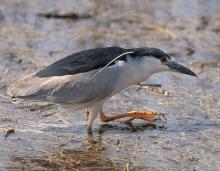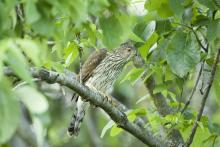Birds
Media

Species Types
Scientific Name
Nycticorax nycticorax
Description
Stocky and short-legged compared to other herons, the black-crowned night-heron has a black crown and back, gray wings, and whitish-gray underparts and head.
Media

Species Types
Scientific Name
Charadrius vociferus
Description
The killdeer is a familiar “shorebird,” but we usually don’t see it near shores! Killdeer prefer open, flat, rather dry areas with short grass, including flooded crop fields, lawns, and sports fields.
Media

Species Types
Scientific Name
Buteo lineatus
Description
The red-shouldered hawk is associated with forests and near water, in places where the lower part of the forest canopy is fairly open. They sit on tree branches and watch for movement on the ground.
Media

Species Types
Scientific Name
Buteo platypterus
Description
The broad-winged hawk is stocky, with a large head and short tail. They are often seen migrating in large flocks. From below, note the pointed wingtips and broad black trailing edge to the pale wings.
Species Types
Scientific Name
Parkesia motacilla (formerly Seiurus motacilla)
Description
The Louisiana waterthrush is a warbler that typically walks along the banks of flowing streams, pecking at insects and other small invertebrates. Its loud, ringing song is distinctive.
Media

Species Types
Scientific Name
Oxyura jamaicensis
Description
The ruddy duck is small, compact diving duck with a long, stiff tail that is often cocked up. Breeding males are conspicuous with their dark cinnamon body, bright white cheek patch, black head, and blue bill.
Media

Species Types
Scientific Name
Bucephala albeola
Description
Buffleheads are small, compact ducks with large, rounded heads. They bob lightly in the water, then, in a flash, dive below the surface.
Media

Species Types
Scientific Name
Bucephala clangula
Description
The common goldeneye is a common migrant and winter resident in Missouri. A diving duck, it is usually found on open water of rivers and lakes.
Media

Species Types
Scientific Name
Pandion haliaetus
Description
Osprey, also called fish hawks or fish eagles, used to be more common in our state, but their numbers are increasing. Keep an eye out for them, especially around reservoirs and during spring and fall migration, as reintroduction efforts are paying off!
Media

Species Types
Scientific Name
Accipiter cooperii
Description
Cooper's hawks have short, rounded wings and long, narrow, rudderlike tails. They are frequently seen foraging along hedgerows and brush-entangled fencerows.
See Also







Media

Species Types
Scientific Name
Hemaris diffinis
Description
The snowberry clearwing is a moth that confuses people because it looks like a bumblebee and flies like a hummingbird!
Media

Species Types
Scientific Name
Hyles lineata
Description
The white-lined sphinx moth sometimes confuses people because it flies, hovers, and eats from flowers like a hummingbird. The adults often fly during daylight hours as well as in the night and are often found at lights.
Media

Species Types
Scientific Name
Darapsa myron
Description
The Virginia creeper sphinx moth is common in woods and brushy areas and comes to lights at night. The larvae eat Virginia creeper and grape leaves.
Media

Species Types
Scientific Name
Perimyotis subflavus (formerly Pipistrellus subflavus)
Description
Tri-colored bats, formerly called eastern pipistrelles, are relatively small and look pale yellowish or pale reddish brown. The main hairs are dark gray at the base, broadly banded with yellowish brown, and tipped with dark brown.
Media

Species Types
Scientific Name
Myotis grisescens
Description
Gray myotises are difficult to distinguish from other mouse-eared bats. A key identifying feature of the gray myotis is that its wing is attached to the ankle and not at the base of the toes. It’s an endangered species.
Media

Species Types
Scientific Name
Myotis lucifugus
Description
The little brown myotis (little brown bat) is one of our most common bats, but populations are declining. White-nose syndrome has taken a heavy toll in northeastern states. This species is now listed as vulnerable across its range.
Media

Species Types
Scientific Name
Myotis sodalis
Description
The Indiana myotis, or Indiana bat, summers along streams and rivers in north Missouri, raising its young under the bark of certain trees. It is an endangered species.
About Birds in Missouri
About 350 species of birds are likely to be seen in Missouri, though nearly 400 have been recorded within our borders. Most people know a bird when they see one — it has feathers, wings, and a bill. Birds are warm-blooded, and most species can fly. Many migrate hundreds or thousands of miles. Birds lay hard-shelled eggs (often in a nest), and the parents care for the young. Many communicate with songs and calls.





















